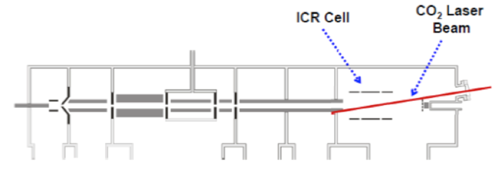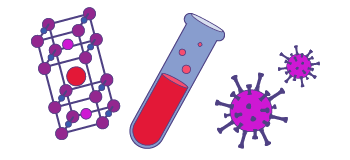Infrared multiphoton dissociation (IRMPD) is often used in conjunction with Fourier transform ion cyclotron resonance mass spectrometry (FT-ICR MS) to fragment gas-phase ions inside the ICR cell.
Infrared multiphoton dissociation (IRMPD) is often used in conjunction with Fourier transform ion cyclotron resonance mass spectrometry (FT-ICR MS) to fragment gas-phase ions inside the ICR cell. A CO2 laser is aligned to send a beam of infrared photons through a window at the end of the vacuum chamber to the center of the ICR cell. The ions trapped at the center of the cell can absorb multiple photons if their vibration is resonant with the laser frequency. The ion’s absorption of photons results in the excitement of the ion to higher energy states, and ultimately dissociation if enough energy (in photons) is absorbed to break a bond within the ion. The amount of energy infused into the system is a function of laser power and irradiation time and is tunable.

IRMPD FT-ICR MS is uniquely suited for understanding the molecular structure of complex mixtures such as heavy petroleum, asphaltenes, dissolved organic matter, and photooxidation products from microplastics. The fragmentation of ions inside de ICR cell, by IRMPD, enables advanced precursor ion isolation via stored waveform inverse Fourier transform (SWIFT). The application of a SWIFT waveform to quadrupole-selected precursor ions, trapped in the ICR cell, enables the isolation of ions with specific mass defects.
For example, Figure 5 presents the structural analysis of coal asphaltenes. Panel a) presents a quadrupole isolation, which is compared with the use of a multinotch SWIFT waveform (in addition to quadrupole isolation, panel b). The quadrupole isolated precursors feature mass defects from ∼0.0500 to 0.4000 Da, which translates into a wide range of double-bond equivalents (rings plus double bonds), as pointed out by the DBE versus carbon number plot for monoheteroatomic precursor ions (N1, O1, S1, circled in red). Upon IRMPD, the fragmentation mass spectrum (panel a, right side) features a low MWD (m/z 120-300, green dashed line) and dealkylation fragmentation with similar abundances. The compositional range for precursors and fragments, combined in the same plot (panel a, right side) demonstrates the production of high- and low-DBE fragments. Since the quadrupole-isolated precursor ions span low and high DBE values, it is impossible to determine whether the high DBE precursors yield low DBE fragments, which is critical for understanding the chemistry of complex mixtures such as crude oil, biofuels, and DOM.
Advanced understanding of the structure of complex mixtures is achieved by applying a multinotch SWIFT waveform (highlighted in purple, panel b) to the quadrupole isolated ions, once they are trapped inside the ICR cell. In this case, the application of the SWIFT waveform enables the isolation of ions with low mass defect/high DBE (˂0.250000, DBE˃16) through ejection of ions with higher mass defects outside of that window (high SWIFT amplitude). Therefore, only ions within a 4-Da isolation window with a mass defect lower than 0.25000 Da remained in the ICR cell prior to IRMPD. The compositional range for the SWIFT-isolated precursor ions demonstrates the efficacy of the method as only high-DBE precursors are present prior to IRMPD. The fragmentation mass spectrum reveals both dealkylation (blue arrow) and the low MWD with lower relative abundance, which suggests that high DBE precursors can yield low DBE fragments. This knowledge is central to predict the processability of feedstocks to produce high value fuels and the fate of emerging contaminants in the environment.
For additional information, see https://pubs.acs.org/doi/abs/10.1021/acs.energyfuels.9b03527


Explore our magnet schedule to see what exciting research is happening on our stellar fleet of instruments right now.
Niles et al. Comprehensive Compositional and Structural Comparison of Coal and Petroleum Asphaltenes Based on Extrography Fractionation Coupled with Fourier Transform Ion Cyclotron Resonance MS and MS/MS Analysis, Energy Fuels 2020, 34, 2, 1492–1505 Read online.
Chacon-Patino et al. Advances in Asphaltene Petroleomics. Part 1: Asphaltenes Are Composed of Abundant Island and Archipelago Structural Motifs, Energy Fuels2017, 31, 12, 13509–13518 Read online.
Targeted Annotation of S-Sulfonylated Peptides by Selective Infrared Multiphoton Dissociation Mass Spectrometry Borotto, N.B.; McClory, P.J.; Martin, B.R. and Hakansson, K. Analytical Chemistry, 89, 16, 8304-8310 (2017) Read online.
M. Schäfer, et al, Kinetic Determination of Potassium Affinities by IRMPD: Elucidation of Precursor Ion Structures, J. Phys. Chem. A. 113(27), 7779-7783 (2009) Read online.
M. Schäfer, et al, Structurally related non-covalent complexes examined by quadrupole ion trap (QIT) MS2 and infrared multiphoton dissociation Fourier transform ion cyclotron resonance mass spectrometry IRMPDFT-ICR MS: evidence for salt-bridge structures in the gas phase, International Journal of Mass Spectrometry 237(1), 33-45 (2004) Read online.
K. Håkansson, et al, Combined electron capture and infrared multiphoton dissociation for multistage MS/MS in a Fourier transform ion cyclotron resonance mass spectrometer, Analytical Chemistry 75(13), 3256-3262 (2003) Read online.
For more information please contact Amy McKenna, Manager, ICR User Program.
Last modified on 23 December 2022